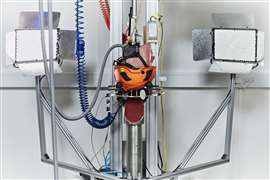OSHA switches from traditional hard hats to safety helmets
December 14, 2023
 A Mips-equipped safety helmet with chin strap in a testing rig. (Image: Mips)
A Mips-equipped safety helmet with chin strap in a testing rig. (Image: Mips)
The US Department of Labor’s Occupational Safety and Health Administration (OSHA) is replacing the traditional hard hats used by its employees with safety helmets.
It said it was taking the move to ensure that its employees were better protected on inspection sites.
Traditional hard hats, which date back to the 1960s, lack chin straps and have little side impact protection.
OSHA said that they could fall off a worker’s head if they slip or trip, leaving them unprotected. Traditional hard hats also lack vents and can trap heat inside, it said.
Justifying its decision, OSHA said that head injuries accounted for nearly 6% of non-fatal occupational injuries involving days away from work in the US.
Almost half of those injuries occurred when workers came into contact with an object or equipment, while about 20% were caused by slips, trips and falls.
It went on to recommend that safety helmets be used by people working at construction industry and the oil and gas industry; in high-temperature, specialized work and low-risk environments; performing tasks involving electrical work and working from heights; and when required by regulations or industry standards.
STAY CONNECTED



Receive the information you need when you need it through our world-leading magazines, newsletters and daily briefings.
CONNECT WITH THE TEAM









